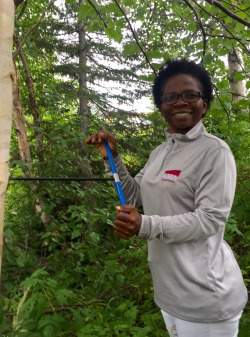Core Issues

Research conducted in Happy Valley-Goose Bay, Labrador, studies whether trees in the region absorb contaminants and how tree cores can help in the preliminary evaluation of contaminated sites.
Dr. Merline Fonkwe is a research associate with the Labrador Institute, where she is responsible for the mineral deposits and environmental geochemistry program. She is also a registered professional geoscientist with the Association of Professional Engineers and Geoscientists of Newfoundland and Labrador. She is the principal investigator of a team of researchers using tree cores to study subsurface contaminants in northern environments.
Northern environmental assessments
Funded by the Harris Centre-MMSB Waste Management Applied Research Fund (2014–15), this project is the first to use tree cores to study contaminants and evaluate how the method can be used in a waste management context in Newfoundland and Labrador.
Research was conducted at the former landfill site of the Canadian Forces Base 5 Wing Goose Bay in Happy Valley-Goose Bay. Dr. Fonkwe says the site is known to be contaminated and assessment and cleanup activities have been undertaken since the early ’90s and are still ongoing.
She says there are many communities in Labrador and other northern areas of Canada investigating contaminated sites, such as waste disposal sites for communities, areas of former military operations and tailings from past mineral exploration and mining activities. Dr. Fonkwe says analysis of tree cores could be a useful method for long-term environmental assessment and monitoring.
Fast, non-destructive, ideal for remote sites The technique, also called tree coring, uses trees and their annual growth rings as indicators of changes in environmental conditions. The research team took samples from mature and healthy looking trembling aspen, black spruce and white birch trees at the site. Dr. Fonkwe extracted small wood cylinders from the tree trunk and analyzed their chemical composition. “The detection of these contaminants in tree cores is a strong indicator of their presence in soil, groundwater and/or air,” she said.
Dr. Fonkwe says traditional techniques involve drilling boreholes and monitoring wells for soil and groundwater sampling. Traditional soil and groundwater sampling techniques can be invasive, time-consuming, and costly. “Tree-core sampling is simple, fast, non-destructive and cheap and therefore does not require expensive equipment or highly specialized personnel,” she explained. “It is particularly useful at remote sites, sites with limited historical records on the contaminating activities, urban sites with dense underground and surface infrastructures or swampy areas where drilling soil boreholes and monitoring wells can be complicated or impossible.” Strategic benefits She’s hopeful that the tree-core method could be used by mineral exploration and waste facilities, as well as environmental protection organizations. As a pre-screening method, Dr. Fonkwe says tree-coring has strategic benefits to the province to enable assessment of environmental baselines and identify timing and sources of contamination. She says future research includes evaluating if the tree-core method can be used to locate persistent organic pollutants, and applying the tree-core method in biogeochemical surveys for key mineral resources in Labrador. Some of the results of this project have been published in Environmental Science and Pollution Research (2016).